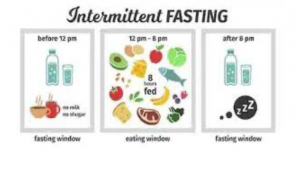How to Use Intermittent Fasting for Weight Loss
Intermittent fasting is a secret for weight loss that you may not know about yet.
No longer is it 100% true that you have to eat breakfast every single day or that you have to eat three meals a day and snacks in order to survive. You can simply extend the amount of time during the day that you do not eat – and if you do it right, the excess weight you have wanted to lose will be gone over time.
7 Guidelines for Intermittent Fasting Weight Loss
Here are some guidelines that will help you with the process:
-
Select Your Best IF Plan
Intermittent fasting means not eating or drinking any beverages with the exception of water for 12 hours, 14 hours, 16 hours or 18 hours. Choose one of these time frames. If you want to make it easy, choose 12 hours. If you want maximum weight loss, choose 16 or 18 hours.
Then choose your time frames for eating and write it down in several places so you don’t forget it. We’ve made it easy for you here:
12 Hour IF Plan 14 Hour IF Plan
Eating Times Fasting Times Eating Times Fasting Times
6am-6pm 6pm-6am 6am-4pm 4pm-6am
8am-8pm 8pm-8am 8am-6pm 6pm-8am
10am-10pm 10pm-10am 10am-8pm 8pm-10am
Noon-Midnite Midnite-Noon Noon-10pm 10pm-Noon
16 Hour IF Plan 18 Hour IF Plan
Eating Times Fasting Times Eating Times Fasting Times
6 am-2pm 2pm-6am 6am-Noon Noon-6am
8am-4pm 4pm-8am 8am-2pm 2pm-8am
10am-6pm 6pm-10am 10am-4pm 4pm-10am
Noon-8pm 8pm-Noon Noon-6pm 6pm-Noon
Select the plan that matches your ideal work schedule right now. For example, it’s not feasible to figure that your regular workday will be your fasting times. This may put too much stress on you, as situations at work may arise where you will have to choose to break your fast due to peer pressure and then you’ll feel guilty. However, if your eating times correspond to your usual work day, it may be easier to follow.
There is something else you should consider. Changing to an IF is altering your eating biorhythms a bit. Try not to alter it so much that you create an eating disorder. For example, there is an eating disorder where someone eats >25% of the calories for the day after 7 pm. If you’re on the usual 6am-10pm wake cycle, eating most of your calories after 7 pm will significantly alter your eating biorhythms for the worst. It can end up causing metabolic disorder, sleep disruptions, and chronic illnesses.
-
Prepare for Hunger
Decide what things you can do to distract yourself from food during the fasting times. Will you go for a walk, read a book, clean something in the house, call a friend, or do a facial mask? Make a list of the things that you could do during these times so you stay on track.
-
Get More Water In
Determine four ways you can get more water in during your fasting times. These four ways could include adding a piece of fruit to the water, squeezing a bit of flavor into the water, adding flower remedies to the water, or using a Zero Water Filter on the tap water to purify it.
One additional way to consume more water is to make a label that says “Love” and “Gratitude” on it and taping this on the bottle. As crazy as it may sound, the vibration of the words love and gratitude is transferred to the water, making it taste better. Check out some Youtube videos by the scientist M. Emoto, who discovered that words change the crystalline structure of water.
Drinking water is essential to the breakdown of fat for weight loss. If you don’t drink enough water, you block your own weight loss efforts. The target amount of water to aim for is one ounce for every 2 lbs body weight.
-
Plan Your Meals and Watch the Meal Size
Plan on two to three meals during the eating time of the day. Don’t eat for the sake of eating; eat smaller meals if you find you cannot eat regularly sized meals. Keep meal regularity as much as possible.
Remember that on an IF plan, you still choose healthy foods. You still stay away from sugar, bad fats, and junk foods. The heart of the IF Plan is simply that you are merely changing the times of the day when you are eating and not eating. And when you don’t eat during the day, your body goes into repair mode. This is how you get rejuvenated during IF plans.
-
Reframe Hunger
If you get hungry during the fasting time period, do your best to reframe the hunger into something positive. One way to do it is to tell yourself that if you are hungry, you will see better weight loss on the scale the next day. Work through it; you can gain mastery over this after a few times of success.
-
What to Do If You Can’t Follow Through 100%
Remember that there are many types of IF plans you could select. Thus, if you find it’s too difficult at first to do an IF plan for 7 days a week, say for a few weeks or a month, then change your plan to 3 or 4 days a week to ease into it. You’ll still get benefits.
-
Keep a Journal
Keeping a journal on the times you eat and fast, and the meals you eat will help you see patterns that are contributing to your weight loss. This doesn’t have to be that elaborate.
Getting in the habit of doing intermittent fasting during the month either a week a month or even a few days a week each month of the year, is one of the best habits you can do to improve your health.
Join Our Community
Archives
- January 2023
- December 2022
- September 2022
- August 2022
- June 2022
- May 2022
- April 2022
- March 2022
- February 2022
- January 2022
- December 2021
- November 2021
- October 2021
- September 2021
- August 2021
- July 2021
- June 2021
- May 2021
- March 2021
- September 2020
- August 2020
- July 2020
- June 2020
- May 2020
- April 2020
- March 2020
- February 2020
Subscribe

Sign up to receive FREE toolkit
From Dr. Hyman, #1 NY Times & Amazon Author
We never spam or sell your e-mail





Follow Our Every Move